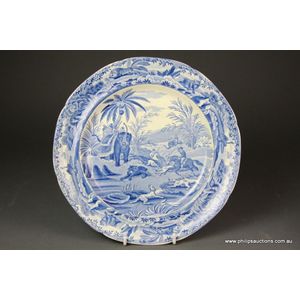Spode Pearlware Plate in Grasshopper Pattern
You must be a subscriber, and be logged in to view price and dealer details.
Subscribe Now to view actual auction price for this item
When you subscribe, you have the option of setting the currency in which to display prices to $Au, $US, $NZ or Stg.
- Pearlware - Pearlware is a type of earthenware pottery that was developed in the late 18th century in England, made from a mixture of clay, flint, and other materials, and is distinguished by its smooth, creamy white glaze. The glaze has a pearlescent quality, which is how the pottery got its name.
Pearlware was developed as a more affordable alternative to porcelain, which was much more expensive and difficult to produce. It quickly became popular throughout England and Europe, and was exported to other parts of the world as well. It was particularly popular for making tableware, such as plates, bowls, and teapots, as well as decorative objects like figurines and vases.
One of the most distinctive features of pearlware is its blue decoration. Many pieces of pearlware were decorated with blue patterns or designs, often featuring pastoral scenes, floral motifs, or geometric patterns. The blue decoration was typically applied over the white glaze, which created a striking contrast and made the designs stand out. - Circa - A Latin term meaning 'about', often used in the antique trade to give an approximate date for the piece, usually considered to be five years on either side of the circa year. Thus, circa 1900 means the piece was made about 1900, probably between 1895 and 1905. The expression is sometimes abbreviated to c.1900.
- Chinoiserie - Furniture and decorative items decorated in imitation of a Western interpretation of the Chinese style. The Chinoiserie style first became popular in the late 17th century, though there were frequent revivals, notably by Chippendale (hence 'Chinese Chippendale') during the Regency period, and the Anglo-Japanese style in the second half of the 19th century.
The ubiquitous 'willow pattern' is the most common 'Chinese' theme used in porcelain, while on furniture the Chinoiserie style usually has black or red painted and lacquered decoration, though the hallmark of the furniture style is the use of fretwork in geometrical patterns, pagodas and other decorative forms.
Japonaiseries, as the name implies, are motifs in imitation of the Japanese taste.
See also "Chinese Chippendale".
This item has been included into following indexes:
-
Copeland Spode (England), item types
- plates 181
- plates and platters 224
- Copeland Spode (England), patterns
Visually similar items

A set of four Spode 'Grasshopper' pattern side plates, 1820s, circular with indented edge, transfer printed in blue, printed 'Stone-china' mark underside, diameter: 18.5 cm

A Spode blue and white dish, circa 1820, with a fluted edge and slightly recessed rim, decorated in 'Filigree' pattern, with a central bouquet of flowers in a basket surrounded by a circular border, the rims with a continuous tendril and foliate design of

A rare Spode Indian Sporting series plate, circa 1810, 'Death of the bear', in an all over blue and white print depicting a colonial hunt of a bear, the rim with a continuous scene of exotic animals amidst lush foliage; with impressed Spode mark underside

Two Chinese blue and white porcelain plates, one 18th century with brown edge rim, the other late-19th century. Diameter 23 cm
